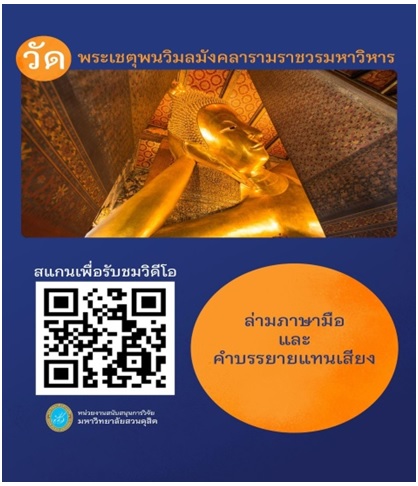THE DEVELOPMENT OF DIGITAL TECHNOLOGY FOR DEAF TO PROMOTE ACCESS TO INFORMATION OF ARCHAEOLOGICAL SITES AND TOURIST ATTRACTIONS
DOI:
https://doi.org/10.14456/nrru-rdi.2023.35Keywords:
Digital technology, Information access, Deaf, Historical sites and tourist attractionsAbstract
Assisting hearing impaired in communicating and connecting more extensively with society has become the focus of research and development. The objectives of this research aimed at 1) developing digital technology for the hearing impaired, and 2) testing the effectiveness of digital technology in promoting the access to information in historical sites and tourist attractions. The sample was selected using purposive sampling of 40 people and a target group of 5 people. The instruments used were a problem and needs assessment, a suitability and effectiveness assessment questionnaire, a pre- and post-testing, and a satisfaction questionnaire. The questionnaires indicated a consistency value between the questions with research objectives ranging from 0.60 to 1.00. Data was collected following a six-step development process and analyzed using statistical measures, including mean, standard deviation, Index of Item Objective Congruence, and dependent t-test. The findings indicated that the level of digital technology problems was moderate ( =2.93, SD=1.26), while the level of digital technology needs was high (
=4.08, SD=0.98). Therefore, videos were developed alongside creating QR codes to disseminate information in historical sites and tourist attractions, aiming to promote information accessibility for the hearing impaired. These digital technologies were found to be appropriate and high quality based on evaluation criteria, with significant differences in the average scores of the developed digital technology usage at a significance level of 0.05. The satisfaction was at the highest level (
=4.97, SD=0.08), demonstrating results that could be utilized to promote learning for the hearing impaired effectively.
References
Bunchua, T. (2019). Persons with Disabilities and the Access, Reveive or Utilize the Television Services. NBTC Journal, 122-146. (In Thai)
Denso-wave. (2019). QR Code development story. Retrieved 15 January 2021, from https://www.denso-wave.com/en/technology
Escudeiro, N., Escudeiro, P., Cunha, B., & Gouveia, M. C. (2023). Inclusive Cultural Heritage Tourism. In Advances in Tourism, Technology and Systems: Selected Papers from ICOTTS 2022, Volume 2 (pp. 207-217). Singapore : Springer Nature Singapore. https://doi.org/10.1007/978-981-19-9960-4_19
European Commission. (2021). Tourism for all. Retrieved 15 January 2021, from https://ec.europa.eu/growth/sectors/tourism/business-portal/accessibility_en
Gabler, P., Geiger, B. C., Schuppler, B., & Kern, R. (2023). Reconsidering Read and Spontaneous Speech: Causal Perspectives on the Generation of Training Data for Automatic Speech Recognition. Information, 14, 137(1-21). https://doi.org/10.3390/info14020137
Haleem, A., Javaid, M., Qadri, M. A., & Suman, R. (2022). Understanding the role of digital technologies in education: A review. Sustainable Operations and Computers, 3, 275-285. https://doi.org/10.1016/j.susoc.2022.05.004
Hasanova, Z., & Inoyatova, D. (2023). THE ROLE OF INFORMATION TECHNOLOGY IN THE PREPARATION OF HEARING IMPAIRED CHILDREN FOR SCHOOL EDUCATION. International Bulletin of Engineering and Technology, 3(6), 198-202.
ISTO (2020). Who we are-Organisation internationale du tourisme social. Retrieved 18 December 2020, from: https://isto.international/who-we-are/
Jobirovich, Y. M. (2022). EFFECTIVENESS OF USING DIGITAL TECHNOLOGIES IN EDUCATIONAL SYSTEM. EUROPEAN JOURNAL OF MODERN MEDICINE AND PRACTICE, 2(4), 124-128.
Marčeková, R., Šebová, L’., Pompurová, K., & Šimočková, I. (2021). Accessible tourism-current state in Slovakia. Entrepreneurship and Sustainability Issues, 9(1), 66-86. http://doi.org/10.9770/jesi. 2021.9.1(5)
Miletić, A., Kuveždić Divjak, A., & Welle Donker, F. (2023). Assessment of the Croatian Open Data Portal Using User-Oriented Metrics. ISPRS International Journal of Geo-Information, 12(5), 185(1-22). https://doi.org/10.3390/ijgi12050185
Ministry of Information and Communication Technology. (2016). Digital Development Plan for the Economy and Society. Retrieved June 25, 2021, from https://www.ops.go.th/main/images/2016/digital-thailand.pdf (In Thai)
Phattharachachai, V. (1996). Principles of Research (3rd ed.). Bangkok : Inter-Tech Printing. (In Thai)
Phromwong, C. (1977). Educational Media System. Bangkok : Chulalongkorn University Press. (In Thai)
Santagata, R., König, J., Scheiner, T., Nguyen, H., Adleff, A. K., Yang, X., & Kaiser, G. (2021). Mathematics teacher learning to notice: A systematic review of studies of video-based programs. ZDM–Mathematics Education, 53(1), 119-134. https://doi.org/10.1007/s11858-020-01216-z
Semchan, K. (2021). Environment Literacy Through Cerative Media of the Deaf Students. Thesis, Master of Arts Program in Man and Environment Management, Chiang Mai University, Chian Mai. (In Thai)
Srisa-ard, B. (2017). Preliminary research (10th ed.). Bangkok : Suweeriyasan. (In Thai)
Sukmawati, E., Adhicandra, I., Sucahyo, N., Ayuningtyas, A., & Nurwijayanti, K. N. (2023). Information System Design of Online-Based Technology News Forum. International Journal Of Artificial Intelligence Research, 6(1.2).
Sukwiboon, T. (2009). Considerations in the construction of Rating Scale tools for research purposes. Retrieved June 25, 2021, from http://ms.src.ku.ac.th/schedule/Files/2553/Oct/1217086.doc (In Thai)
The National Broadcasting and Telecommunication Commission. (2020). Guidelines for the preparation of sign language interpreters closed captions and audio descriptions for television services. Retrieved June 25, 2021, from https://infocenter.nbtc.go.th/storage/files/_contentSource_20171228_020354_1514444634793.PDF (In Thai)
Tirakanan, S. (2013). Social Science Research Methodology : Guidelines for Practice (11th ed. (revised)). Bangkok : Chulalongkorn University Printing House. (In Thai)
Tytarenko, I., Pavlenko, I., & Dreval, I. (2023). 3D Modeling of a Virtual Built Environment Using Digital Tools: Kilburun Fortress Case Study. Applied Sciences, 13(3), 1577(1-13). https://doi.org/10.3390/app13031577
Wahyuni, A., & Utami, A. R. (2021). the Use of Youtube Video in Encouraging Speaking Skill. Pustakailmu. Id, 7(3), 1-9.
Wanichbuncha, K. (2018). Statistics for research (12th ed.). Bangkok : Sam Lada. (In Thai)
Wongrattana, C. (2017). Techniques for using statistics for research (13th ed. (Additional Revised Edition)). Bangkok : Chulalongkorn University Book Center. (In Thai)
Worakham, P. (2018). Educational research (8th ed.). Maha Sarakham : Taxila Printing. (In Thai)
Zhang, S., Liao, J., Wu, S., Zhong, J., & Xue, X. (2021). A traceability public service cloud platform incorporating IDcode system and colorful QR code technology for important product. Mathematical Problems in Engineering, Article ID 5535535, 1-15. https://doi.org/10.1155/2021/5535535

Downloads
Published
How to Cite
Issue
Section
License

This work is licensed under a Creative Commons Attribution-NonCommercial-NoDerivatives 4.0 International License.




